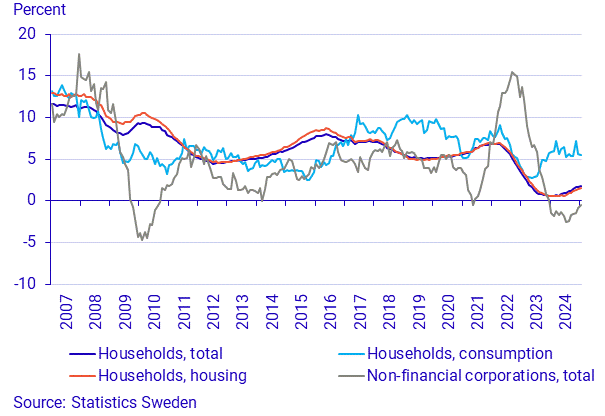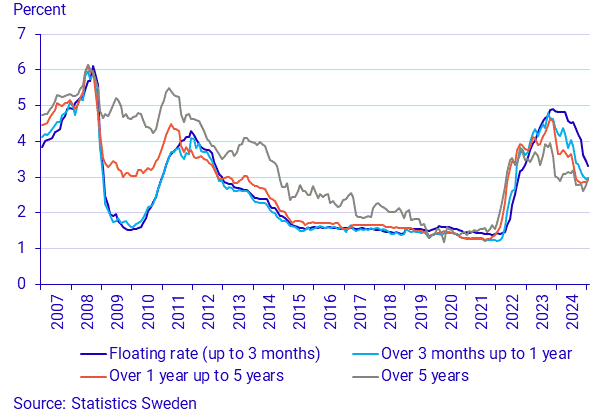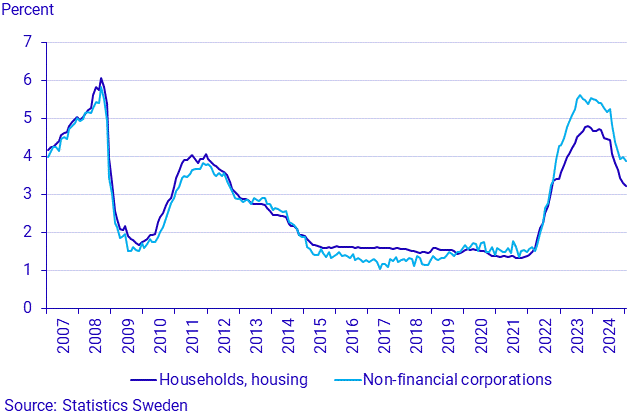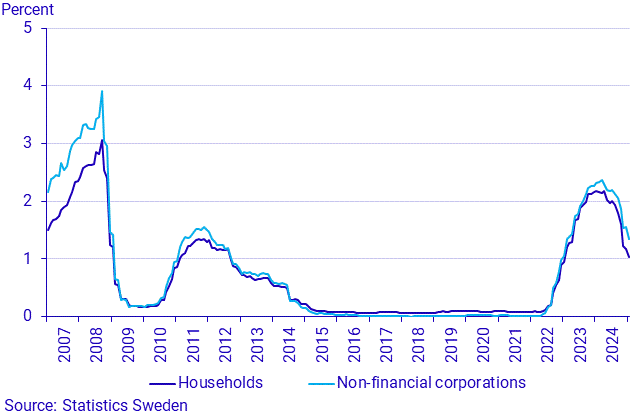Financial market statistics, January 2025
Fixed housing loans interest rates increases
Statistical news from Statistics Sweden 2025-02-27 8.00
The floating interest rate for housing loans continues to decrease in January, at the same time the fixed interest rate for housing loans over 3 months increases. The average floating interest rate for housing loans, household new agreements fell to 3.30 percent in January. MFI's lending to households exceeded for the first time ever SEK 5 000 billions in January.
– The fixed interest rate for household new agreements, housing loans over 3 months increases in January 2025. At the same time the floating interest rate for housing loans continues to decrease, says Tove Åkerrén Ögren, economist at Statistics Sweden (SCB).
Developments in January 2025 summarised
Lending
- The annual growth rate of lending from MFIs (includes banks and mortgage institutions, among others) to households was 1.8 percent in January 2025. Housing loans accounted for 83 percent of total lending to households. The growth rate for housing loans increased from 1.4 percent in December 2024 to a level of 1.6 percent in January 2025. The annual growth rate for consumption loans was 5.5 percent and accounted for 6 percent of total lending to households, to be compared with 5.6 percent in December 2024.
- The annual growth rate for lending to non-financial corporations was -0.5 percent in January 2025.
- In total, lending from MFIs to households and non-financial corporations amounted to SEK 7 950 billion. Loans to households accounted for 63 percent (SEK 5 004 billion) and loans to non-financial corporations accounted for 37 percent (SEK 2 946 billion).

- The annual growth rate of housing loans from institutes other than MFIs on mortgage markets, known as mortgage credit companies, was in January 2025 noted at -0.3 percent. Mortgage credit companies accounted for 1.1 percent (SEK 45 billion) of total housing loans to households which amount to SEK 4 184 billion.
Deposits
- In January 2025, in total, MFI:s deposits from households amounted to SEK 2 748 billion. On demand deposits accounted for 75 percent (SEK 2 064 billion). It is to compare to January 2024 when on demand deposits accounted for 74 percent of total deposits to households (SEK 2 692 billion).
- Notes and coins held by Swedish non-bank public, previously defined as the money supply measurement M0, amounted to SEK 56 billion in January 2025. The money supply M3 amounted to SEK 4 958 billion and had an annual growth rate of 1.6 percent.
Interest rates on lending and deposits
- In January 2025 the average interest rate on new agreements for housing loans to households was 3.23 percent. The average floating rate on housing loans was 3.30 percent in January, compared to 3.46 percent in December 2024.
- The average fixed interest rate between 1 and 5 years on new agreements for housing loans to households was 2.91 percent in January 2025. This can be compared to 2.85 percent in December 2024 and 3.63 percent in January 2024.

- The average interest rate in January 2025 on new agreements for lending to non-financial corporations was 3.86 percent, to be compared with 5.52 percent in January 2024.

- Households’ average interest rate on new bank deposits was 1.03 percent in January 2025, to be compared with 2.18 percent in January 2024. The interest rate on accounts with fixed periods or a limited number of free withdrawals was 1.92 percent in January 2025, compared to 3.40 percent in January 2024.
- Non-financial corporations’ average interest rate for new bank deposits was 1.34 percent. The interest rate on accounts with fixed periods or a limited number of free withdrawals was 2.23 percent.

About the statistics
The financial market statistics cover mainly monetary financial institutions (MFIs), but also include new institutes on mortgage markets, known as mortgage credit companies. Unless otherwise stated, the statistical news refers to MFIs.
The statistics include balance sheet statistics (including lending and deposits), interest rates, and monetary aggregates.
Definitions and explanations
The financial market statistics are compiled monthly. Revisions of the statistics may occur.
Monetary financial institutions (MFIs) comprise banks, housing credit institutions, finance companies, institutions financing municipalities and companies, monetary securities companies and monetary investment funds (money market funds).
Mortgage credit companies refers to non-MFI institutions that have authorisation from Finansinspektionen to issue mortgages. Usually, mortgage credit companies sell the mortgages to alternative investment funds (AIFs). The AIFs included in the financial markets statistics are linked to mortgage credit companies, and whose assets mainly comprise mortgages.
Growth rates are calculated to illustrate the development of transactions as from the corresponding period the previous year. The rates are calculated based on changes in stocks; adjustments are made so that the growth rate is not affected by stock changes unrelated to transactions.
Lending to households is divided into three categories: housing loans, consumer credit, and other lending. The purpose of a loan is not directly measured, but is approximated by categorising lending by type of collateral. Housing loans are defined as loans to private individuals or entrepreneurial households with housing as collateral. Consumer credit refers to lending to private individuals, generally without collateral. Other lending includes all other lending, for example lending to non-profit institutions serving households.
New agreements refer to agreements concluded during a given month. Interest rate statistics on new agreements is a way of measuring the price formation on loans and deposits in a given period. These statistics include all financial agreements in which the terms and conditions affecting the interest rates on deposits and lending are determined for the first time. The statistics also include renegotiations of existing loans and relocation of loans. Changes in floating interest rates due to automatic adjustments are not considered new agreements.
The loan-to-value ratio for all households is based on a sample survey. The statistics for loan-to-value ratios are derived from the MFI institutions included in the sample survey for the interest rate statistics. These statistics are new and may be subject to revision.
Next publishing will be
The next item of statistical news in this series is scheduled for publication on 2025-03-27.
Statistical Database
More information is available in the Statistical Database
Feel free to use the facts from this statistical news but remember to state Source: Statistics Sweden.
